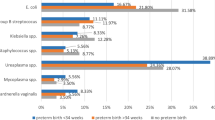Abstract
Purpose
This study was designed to examine the effect of bacterial contamination on in vitro fertilization treatment outcomes.
Method
In a prospective clinical trial, 152 patients aged 23–38 years, mean 33.3 ± 4.6, undergoing IVF treatment were selected for this study. During embryo transfer, separate samples were collected for microbial examination from the following sites: the fundus of the vagina, the cervix, the embryo culture medium prior and post-embryo transfer, the tip of the catheter, and the external sheet. All the samples were separately cultured to identify any bacteria or yeast present.
Results
Pregnancy rates in patients testing positive for Entrobacteriaceae (22.2% versus 51%) and Staphylococcus species (17.6% versus 44%) were significantly lower than those in the negative culture group (p < 0.001). The pregnancy rates do not seem to be affected by the other isolated microorganisms.
Conclusion
This study shows that the presence of vaginal–cervical microbial contamination at the time of embryo transfer is associated with significantly decreased pregnancy rates.

Similar content being viewed by others
References
Roseboom TJ, Vermeiden JPW, Schoute E, Lens JW, Schats R. The probability of pregnancy after embryo transfer is affected by the age of the patient, cause of infertility, number of embryos transferred and the average morphology score, as revealed by multiple logistic regression analysis. Hum Reprod 1995;10:3035–41.
Munne S, Alikani M, Tomkin G, Grifo J, Cohen J. Embryo morphology, developmental rate, and maternal age are correlated with chromosome abnormalities. Fertil Steril 1995;64:382–91.
Karande VC, Morris R, Chapman C, Rinehart J, Gleicher N. Impact of the “physician factor” on pregnancy rates in a large assisted reproductive technology program: Do too many cooks spoil the broth? Fertil Steril 1999;71:1001–9.
Hearns-Stokes RM, Miller BT, Scott L, Creuss D, Chakraborty PK, Segars JH. Pregnancy rates after embryo transfer depend on the provider at embryo transfer. Fertil Steril 2000;74:80–6.
Angelini A, Brusco GF, Barnocchi N, El-Danasouri I, Pacchiarotti A, Selman H. Impact of physician performing embryo transfer on pregnancy rates in an assisted reproductive program. J Assist Reprod Genet 2006;23:329–32.
Egbase PE, Al-Sharhan M, Al-Othman S, Al-Mutawa M, Udo EE, Grudzinskas JG. Incidence of microbial growth from the tip of embryo transfer catheter after embryo transfer in relation to clinical pregnancy rate following in-vitro fertilization and embryo transfer. Hum Reprod 1996;11:1687–9.
Egbase PE, Udo EE, Al-Sharhan M, et al. Prophylactic antibiotics and endocervical microbial inoculation of the endometrium at embryo transfer (letter). Lancet 1999;354:651–2.
Fanchin R, Harmas A, Benaoudia F, Lundkvist U, Olivennes F, Frydman R. Microbial flora of the cervix assessed at the time of embryo transfer adversely affects in vitro fertilization outcome. Fertil Steril 1998;70:866–70.
Moore DE, Soules MR, Klein NA, Fujimoto VY, Agnew KJ, Eschenobach DA. Bacteria in the transfer catheter tip influence the live-birth rate after in vitro fertilization. Fertil Steril 2000;74:1118–24.
Westrom L. Effect of acute pelvic inflammatory disease on fertility. Am J Obstet Gynecol 1975;121:707–13.
Faro S. Chlamydia trachomatis: female pelvic infection. Am J Obstet Gynecol 1991;164:1767–70.
Witkin SS, Sultan KM, Neal GS, Jeremias J, Grifo JA, Rosenwaks Z. Unsuspected Chlamydia trachomatis infection and in vitro fertilization outcome. Am J Obstet Gynecol 1994;171:1208–14.
Witkin SS, Kligman II, Grifo JA, Rosenwaks Z. Chlamydia trachomatis detected by polymerase chain reaction in cervices of culture-negative women correlates with adverse in vitro fertilization outcome. J Infect Dis 1995;17:1657–9.
Ralph SG, Rutherford AJ, Wilson JD. Influence of bacterial vaginosis on conception and miscarriage in the first trimester: cohort study. BMJ 1999;319:220–3.
Liversedge NH, Turner A, Horner PJ, Keay SD, Jenkins JM, Hull MG. The influence of bacterial vaginosis on in-vitro fertilization and embryo implantation during assisted reproduction treatment. Hum Reprod 1999;14:2411–5.
Tatbibzadeh S, Babaknia A. The signals and molecular pathway involved in implantation: a symbiotic interaction between blastocyst and endometrium involving adhesion and tissue invasion. Hum Reprod 1995;10:1579–602.
Paulson RJ, Sauer MV, Lobo RA. Factors affecting embryo implantation after human in vitro fertilization: a hypothesis. Am J Obstet Gynecol 1990;163:2020–3.
Navot D, Anderson TL, Drosech K, Scott RT, Kreiner D, Rosenwaks Z. Hormonal manipulation of endometrial maturation. J Clin Endocrinol Metab 1989;68:801–7.
Czernobilisky B. Endometritis and infertility. Fertil Steril 1978;30:119–30.
Hillier SL, Krohn MA, Rabe LK, Klebanoff SJ, Eschenbach DA. The normal vaginal flora, H2O2-producing lactobacilli, and bacterial vaginosis in pregnant women. Clin Infect Dis 1993;16(Suppl 4):S273–81.
Herath S, Fischer DP, Werling D, Williams EJ, Lilly ST, Dobson H, et al. Expression and function of Toll-like receptor 4 in the endometrial cells of the uterus. Endocrinology 2006;147:562–70.
Author information
Authors and Affiliations
Corresponding author
Additional information
The presence of vaginal-cervical microbial contamination, examined at embryo transfer, has revealed to negatively affect in-vitro fertilization treatment outcome
Rights and permissions
About this article
Cite this article
Selman, H., Mariani, M., Barnocchi, N. et al. Examination of bacterial contamination at the time of embryo transfer, and its impact on the IVF/pregnancy outcome. J Assist Reprod Genet 24, 395–399 (2007). https://doi.org/10.1007/s10815-007-9146-5
Received:
Accepted:
Published:
Issue Date:
DOI: https://doi.org/10.1007/s10815-007-9146-5




